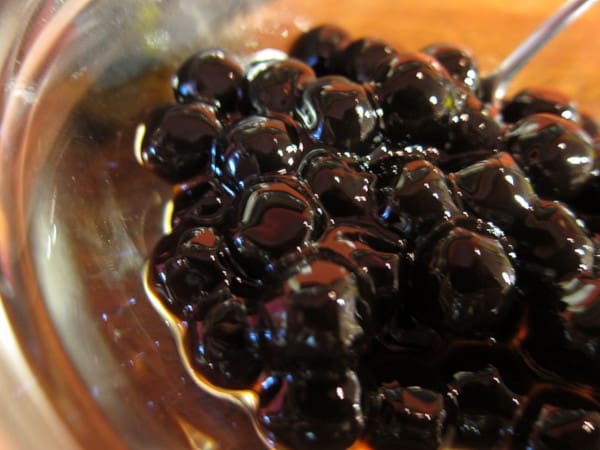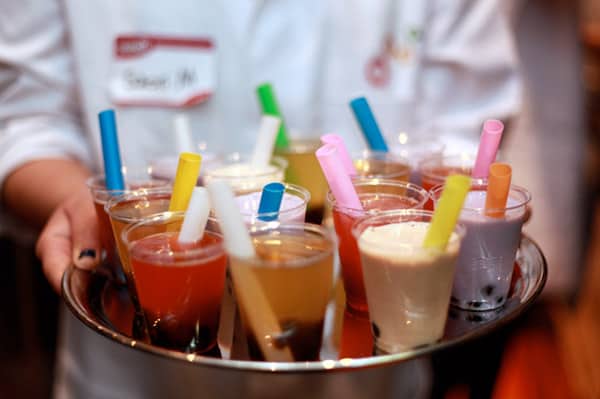Bubble tea or boba tea (zhen chu nai cha) is a highly caffeinated, sugary drink characterized with the signature black tapioca bubbles or “pearls”.
Originated in Taiwan almost four decades ago, somehow boba tea went on to become mainstream popularity not only in Taiwan and China but all over the world.
Here, we will discuss some unique and interesting facts about boba tea.
History of Boba (Bubble Tea)
Boba culture is actually pretty old’ and has started in the late 1980s. It is believed that bubble tea was first invented in Taichung, Taiwan, although there are other cities in Taiwan that often claim their ownership, including Taipei.
Back in the 80s, milk tea was already very popular in Taiwan and throughout East Asia—tea-drinking, after all, is a very important aspect of the Far East’s culture—. At the same time, both tapioca balls and shaved ice were common desserts in Taiwan.
Thus, legend said that a food stall owner thought to combine these three popular desserts together into a single beverage: tapioca balls on the bottom (the bubble or boba), a layer of shaved ice, and the milk tea as the main beverage.
The name “boba” itself is actually a Chinese slang for breasts (to reference the ball shape of the tapioca “bubble”). Obviously the original boba tea back in the 1980s is not 100% similar to what we have today, but rather, it has evolved over time.
As we know, today’s boba tea is not always based on milk tea, but there are also fruit bobas (using fruit powders and syrups), green tea boba, and even more extreme inventions like the cheese tea boba.
The topping choices have also expanded beyond tapioca balls, and now there are variants like egg pudding, red beans, grass jelly, and more.
Nevertheless, the sweet taste of the tapioca bubbles combined with the creamy texture of the milk tea remains the signature characteristic for the boba tea.
So, Who Invented Bubble Tea?
The exact origin of the bubble tea is still the subject of debate. However, it is believed that the birthplace of boba tea is the Chun Shui Tang Teahouse in Taichung.
In the 1980s, the teahouse was rather popular for their iced milk tea, and actually was one of the first vendors who sold the dessert beverage. It is said that the owner of Chun Shui Tang added the iced milk tea to their menu to copy iced coffee, which he tried in Japan.
According to the story, a young employee of the teahouse, Lin Hsui Hui, mixed the tapioca balls into the iced milk tea. The tapioca balls back then were included in a popular pudding dessert called fen yuan.
Although the truth about this story can’t be confirmed and might just be a marketing ploy, almost all food historians agree that boba tea originated from Taiwan’s street food culture in the late 1980s.

What Is Boba Made Of?
The bobas in bubble tea come from the cassava root, Manihot Esculenta, a nutty-flavored underground stem. The bobas, before they are shaped into the glossy balls we know, are extracted starches from these cassava roots, called tapioca starch.
The tapioca starch is then mixed with water and dark brown sugar and shaped into the ball or pearl shape. Tapioca pearls are very versatile, and can be made to vary in textures, shapes, and colors depending on the ingredients.
The dark brown sugar is what gives the boba its dark-brown or black color, but we can use other seasonings to give the bobas different colors.
Check out Bubble tea (Boba) products, here – Aff.link
Is Boba Vegan?
The boba (bubble) itself is usually vegan since the main ingredient, tapioca starch, is not only vegan but gluten-free.
As discussed above, the tapioca pearl (boba) is mainly made from three key ingredients: tapioca starch, water, and another seasoning that gives it color and taste (mainly brown sugar). If the extra seasoning is also vegan, then the boba is 100% vegan.
However, we have to also consider another aspect of the boba tea drink: the “tea” part. Aside from the boba, the bubble tea is typically made in two different ways: as a milky drink or fruity drink.
The fruity tea is almost always vegan and usually based on fruit syrup. The milky tea, however, might or might not be vegan. It’s quite often nowadays that a vegan creamer is offered. Yet, if you are not sure, ask the seller.
An Introduction to Chinese History & Culture (Aff.link)
Dive into China’s rich past and intriguing present! From ancient dynasties to modern powerhouses, uncover Chinese culture facts, pivotal moments, and the captivating tales that have shaped this vast nation.
Is Boba Healthy?
Boba drinks are certainly not the healthiest drink you can choose, but it’s definitely worth the occasional splurging.
Boba drinks are mostly high in sugar, carbs, and calories. A 16oz boba drink can pack around 240 calories, 40 grams of sugar, and 50 grams of carbs.
So, if you are diabetic or are concerned about your waistline, order a smaller serving or opt for a sugar-free/less-sugar options which are offered by many boba tea stalls nowadays.

“Bubbleology” by Serena Sunday is licensed under CC BY-ND 4.0
Why Is It So Popular?
From its origins in Taiwan, Bubble tea spread to other Asian countries especially all over the world. Boba tea became mainstream popularity in the U.S. around 2014. Over the past decade, Bubble tea has become really popular in Mainland China.
So, why is it so popular? There are many different factors that may contribute to this, and we never really get to know why certain foods or beverages reach a critical mass appeal and others don’t.
However, the popularity of boba tea is mainly due to novelty and taste. Boba tea, especially with the tapioca pearl as a new sensation, is something new especially in the western world, so people are naturally curious about it.
Also, bubble tea has a familiar, comforting taste, served just in a cup with a straw. Another factor contributing to the boba tea craze is the fact that it is adopted by the middle class, professional class, so it has prestige.
The higher the class the food/drink is perceived in, the easier it is to become popular, especially with the help of social media today.
According to recent studies, Chinese now consume five times more milk than coffee, which is an amazing feat. At the end of 2018, there are over 450,000 milk tea shops selling bubble tea in China, Yi Dian Dian, Coco, and The Alley are currently the top 3 biggest Bubble Tea brands in china and around the world.
Varieties of Boba Tea
Aside from the signature tapioca pearls (the bobas), boba shops also offer a wide variety of toppings from many flavors of jelly, aloe vera, popping boba, and so on with many different flavors to choose from.
The drink/tea element also offers many different flavors and varieties. There are, for example, salted cheese drinks offered by many different milk tea shops all around the world, and also experimental fruity flavors like strawberry matcha.
All in all, there are hundreds of variations for Boba tea, enough to have a different drink every day for the whole year.
Check out Bubble tea (Boba) products, here – Aff.link
Stay in Touch
 Join our newsletter by using the forms on this website or click here!
Join our newsletter by using the forms on this website or click here! Follow us on Google News
Follow us on Google News Follow us on Facebook
Follow us on Facebook
Feature Image from Depositphotos






